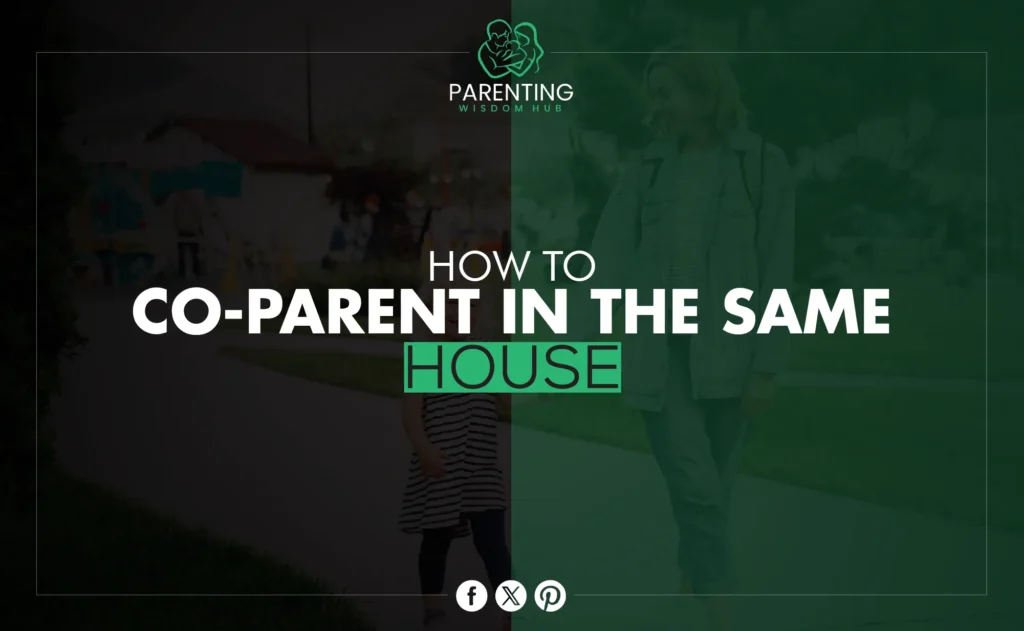Introduction:
Parents, after divorce, face unique obstacles and learning curves. Child mental health depends on co-parenting. Some families benefit from how to co-parent in the same house training. Economic factors and the need for stability and regularity in the child’s environment may drive this arrangement.
If you have other queries, just like Can Co-Parents Get Back Together? You can email us your questions. We will research them and try to provide you with the best solutions or answers. Otherwise, we’ll also cover these questions.
In-house co-parenting decisions are made to minimize child disruption. It requires parental commitment. Knowing the difficulties of coexisting after divorce is crucial. Daily contacts include limiting and being respectful and supportive. This blog post offers strategies to help parents and children handle these issues.
Understanding the Basics of In-Home Co-Parenting
Definition of Co-Parenting and In-Home Co-Parenting
Co-parenting entails two ex-partners working together and respectfully raising their children. In-home co-parenting allows both parents to live together, albeit platonically and formally, to maintain family routines and support for their children.
Benefits of In-Home Co-Parenting for Children
- Stability: Kids do better when their home life stays the same, which makes moving between houses less stressful.
- Consistency: Having both parents close by makes it easier to stick to the same rules and parenting style, which is better for the child.
- Relationships: Frequent contact with both parents helps keep close family ties alive, which is good for the child’s mental and social growth.
The Importance of Mutual Respect and Clear Communication
- Foundation of Cooperation: Respecting each other as co-parents is the first step towards a cooperative and less hostile atmosphere.
- Effective Decision-Making: Both parents need to be able to communicate clearly when making decisions together so that each parent can do their fair share in raising the child.
- Reducing Conflicts: Clear and polite communication helps avoid misunderstandings and fights, which is very important when learning how to co-parent in the same place.
Being aware of these basics is important for successfully navigating the complicated world of in-home co-parenting, keeping the focus on creating the best setting for the children involved.
Setting Ground Rules for Harmony
Importance of Establishing House Rules That Both Parents Agree On
Set explicit house rules to create a peaceful living environment when co-parenting. These guidelines are necessary for order and conflict prevention. For home stability, they ensure that both parents have the same expectations regarding daily routines, discipline, and household administration.
Discussing the Need for Consistent Parenting Styles and Methods
Parenting together requires consistency. Children can feel safe and develop emotionally in a predictable setting. Both parents should agree on basic parenting methods like:
- Disciplinary strategies: Make sure that both parents follow the rules and deal with penalties in the same way.
- Educational involvement: Help students consistently by coordinating their work on homework and school events.
- Bedtime routines: Align bedtime routines and plans to make sure the child gets enough rest without any problems.
Examples of Common Ground Rules
If you want to know how to co-parent in the same house, here are some general rules you might want to follow:
- Schedules for Parenting Time: Set aside time for each parent to care for the child, guaranteeing quality time together.
- Household Responsibilities: To avoid anger, divide household tasks. It could involve dividing cooking, cleaning, and laundry.
- Personal Boundaries: Respect each other’s privacy by setting limits like bedrooms.
Setting and following these ground rules can help both parents create a more calm and cooperative home, which promotes the child’s upbringing and well-being.
Communication Strategies
Successful co-parenting, especially when both parents live together, requires good communication. Effective communication can make shared parenting easier.
Techniques for Effective and Respectful Communication
When learning how to co-parent in the same house, adopting these communication techniques can foster a healthier relationship:
- Active Listening: Listen to one other’s thoughts, feelings, and intentions without interruption to show respect and understanding.
- Use “I” Statements: Express thoughts and needs without accusation (‘I feel overwhelmed when…” vs “You never help with…”).
- Scheduled Discussions: Set regular intervals to discuss household management and child requirements to avoid miscommunications and align parents.
The Role of Mediation or Counseling in Facilitating Communication
Sometimes, despite best efforts, communication can break down. In these instances, seeking external help is beneficial:
- Professional Mediators: Neutral ground and systematic conversation can assist in resolving certain issues.
- Counselors or Therapists: Family therapy and divorce specialists can help both parties understand and accept each other’s perspectives by enhancing communication.
Tools and Apps That Can Aid in Managing Co-Parenting Responsibilities
Several digital tools can help manage the logistics of co-parenting, making it easier to maintain effective communication:
- Shared Calendars (Google Calendar, Cozi): These should be used to schedule child-related activities, appointments, and parenting time to keep both parents informed.
- Dedicated Co-Parenting Apps (OurFamilyWizard, Coparently): These solutions include expense tracking, messaging, and information storage to reduce disputes and simplify responsibility sharing.
These communication tactics make co-parenting in the same house easier and better for parents and children.
Conflict Resolution
When learning how to co-parent in the same house, disputes are inevitable. Maintaining a calm family and protecting children’s emotional well-being requires constructive conflict management.
Tips on How to Handle Disagreements without Escalating Conflicts
- Stay calm and composed: Cool down if you’re emotional. In a rage, you can intensify the conflict.
- Focus on the Issue, Not the Person: Discuss actions, not people. Instead of criticizing others, state the facts and your feelings.
- Seek Compromise: Find solutions that satisfy both parties. Shared parenting typically requires compromise.
The Importance of Not Involving Children in Parental Conflicts
- Shield Children from Adult Issues: Avoid discussing disputes or criticizing the other parent in front of the kids. Children should not have to choose sides.
- Maintain a United Front: To provide children security and constancy, present decisions and regulations as mutually agreed upon, regardless of arguments.
When to Seek Professional Help to Mediate Disputes
- Persistent Disagreements: If issues keep arising without resolution, consider hiring a third party.
- Elevated Conflicts: When conflicts impair daily life or the home’s emotional climate, professional assistance can help.
- Stalled Communication: If communication fails, mediators or therapists can assist in finding new ways to resolve conflicts.
Parents can build a stable, supportive atmosphere that promotes their children’s well-being by handling disagreements and co-parenting. Seeking help is not a sign of failure but a proactive step toward better co-parenting.
Financial Management
Handling Household Expenses and Child-Related Costs
Financial co-parenting in the same residence demands clear agreements and transparency. Parents should clearly divide living expenses, medical bills, school fees, and extracurricular activities. All expenditures must be documented and receipted. By informing both parents about fund usage, this technique promotes transparency and trust.
Creating a Joint Budget for Shared Expenses
Joint budgets improve predictability and financial planning. It allows both parents to plan their budget and anticipate expenses. Setting explicit financial contribution expectations avoids disagreements and ensures fair and agreed-upon financial decisions. A combined budget fosters financial equity, making it easier to allocate spending fairly.
Income-Based Financial Contributions
Financial contributions should match each parent’s income for fair expense sharing. To avoid unduly burdening one parent, this technique considers their finances. Be open to changing these payments if work or financial circumstances change. Regularly examine these financial agreements to ensure they are fair and acceptable for both parents’ financial situations.
Supporting the Children
Reassuring Children and Maintaining Stability
Co-parenting in the same residence should prioritize children’s mental health. Stable and predictable environments reassure children. Parents should keep eating, bedtime, and school schedules. Rituals and small victories can also provide comfort and normalcy.
Handling Discussions about the Living Arrangement
Kids need sensitivity and honesty when discussing co-parenting. When told age-appropriately, children understand that both parents will be involved in their lives despite changes. Parents should answer inquiries honestly and reassure youngsters of their unconditional affection to make them feel safe and loved. Avoid guilting or overwhelming kids with adult difficulties.
Presenting a United Front in Parenting Decisions
Co-parenting in the same residence requires consistency in parenting decisions. It includes setting home rules, discipline, and values. A united parent front emphasizes authority and eliminates confusion for youngsters. It also stops kids from pitting parents against each other. United parenting creates a supportive environment where children can thrive because both parents work together despite their differences.
Conclusion
Recapping Effective In-Home Co-Parenting
Finally, how to co-parent in the same house involves clear communication, mutual respect, and dispute resolution. Harmony requires clear norms and honest financial management. Successful in-home co-parenting requires guaranteeing children’s emotional and psychological well-being. Even with their parents living together post-separation, children can thrive with stable and consistent parenting.
Encouragement for Ongoing Commitment
Parents should remain dedicated to their children’s well-being. Focusing on caring and supporting children is crucial, putting their needs before personal differences. Co-parenting in the same house is difficult, but with effort and collaboration, it can provide a healthy and caring upbringing for the children.


